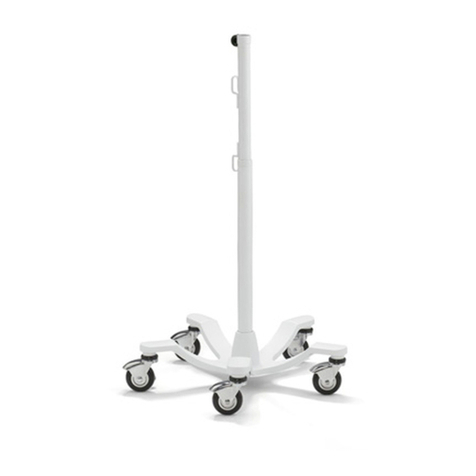
6
of their threaded shafts are flush with the top surface of
the mounting bar.
2. Loosen the two clamp knobs on the dual-width saddle
plate (Figure 7) until the width of one of the dovetail
grooves is slightly wider than the width of the dovetail bar
on your telescope.
3. While holding the telescope, seat the dovetail bar of the
telescope into the proper groove of the saddle. The lower
groove is for a “narrow” (Vixen style), 45mm width dove-
tail bar and the upper groove is for a “wide” (Losmandy
style), 75mm bar. (The included dovetail bar fits the nar-
row groove.) Then tighten the two clamp knobs to secure
the dovetail bar in the saddle.
Warning: Keep supporting the telescope until you are
sure it has been firmly attached to the saddle!
5. Balancing the Telescope
To minimize stress on the motor drive system and ensure
smooth, accurate movement of a telescope on both axes of
the mount, it is imperative that the optical tube be properly
balanced. We will first balance the telescope with respect to
the right ascension (R.A.) axis, then the declination (Dec.)
axis.
1. Keeping one hand on the telescope optical tube, loosen
the R.A. lock lever (refer to Figure 8). Make sure the Dec.
lock lever is tightened, for now. The telescope should now
be able to rotate freely about the R.A. axis. Rotate it until
the counterweight shaft is parallel to the ground (i.e., hori-
zontal).
2. Now loosen the counterweight lock knob and slide the
weight(s) along the shaft until it exactly counterbalances
the telescope. That’s the point at which the shaft remains
horizontal even when you let go with both hands. Once
balance is achieved, retighten the counterweight lock
knob.
3. To balance the telescope on the Dec. axis, first tighten the
R.A. lock lever, with the counterweight shaft still in the hor-
izontal position. Then with one hand on the telescope opti-
cal tube, loosen the Dec. lock lever and check for any rota-
tion. If there is some, adjust the telescope forward or back
in the saddle or in its tube rings until it remains horizontal
when you carefully let go of it. You may want to rotate the
RA axis back to the home position (counterweight shaft
pointing downward) before making any adjustments to the
position of the telescope in the saddle or tube rings.
The telescope is now balanced on both axes. When you loos-
en the lock lever on one or both axes and manually point the
telescope, it should move without resistance and should not
drift from where you point it.
NOTE: For imaging, it is recommended that the mount
be slightly IMBALANCED – weighting the R.A. axis to the
EAST and the Dec. axis in either direction.The imbalance
should be very slight and should be implemented after
you have found the correct balance point using the above
procedure.This weight offset keeps a minimal load on the
gears at all times, which improves guiding behavior.
So for the R.A. axis, if the telescope is on the west side of the
mount, slide the counterweight down the counterweight shaft
(which is on the east side of the mount) a bit – 3 centimeters
or so should be enough. If the telescope is on the east side of
the mount, slide the counterweight up the shaft by the same
distance.
6. Setting Up and Using the
Equatorial Mount
When you look at the night sky, you no doubt have noticed that
the stars appear to move slowly from east to west over time.
That apparent motion is caused by the Earth’s rotation (from
west to east). An equatorial mount is designed to compensate
for that motion, allowing you to easily “track” the movement of
astronomical objects, thereby keeping them from drifting out
of your telescope’s field of view while you’re observing.
Figure 7. The dual-width saddle accommodates narrow or wide
dovetail mounting bars or plates.
Figure 8. The R.A. and Dec axes of the Atlas EQ-G and related
parts.
Dec. lock lever
(not shown)
Front
opening
R.A. lock
lever
Polar axis
finder scope
Latitude
scale
Latitude
adjustment
L-bolts
Azimuth
adjustment knobs (2)
Declination (Dec) axis
Right Ascension
(R.A.) axis
Wide
Narrow
















































